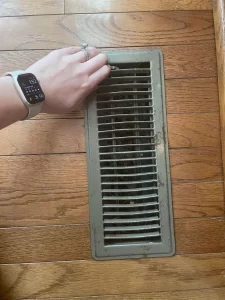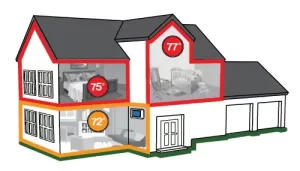 Closing air vents is the easiest way to save money on your heating and air bills, right?
Closing air vents is the easiest way to save money on your heating and air bills, right?
Actually…
Many homeowners believe that closing vents in unused rooms will redirect air to keep only the rooms they care about comfortable, thus saving them on energy bills from heating and cooling rooms they don’t care about. However, quite the opposite is true.
Does Closing Vents Redirect Air?
The short answer is – no, not really. Completely closing an air vent just blocks one path of air, but does not simply encourage the remaining air flow to just go to other rooms. The consequences of blocking air flow to a particular room can be serious.
The HVAC system was sized and designed to heat and cool the entire size of your home.
When you are shutting off part of the home from the ductwork system, the heating and air conditioning unit will try to overcompensate. In the winter, for example, when a vent is closed it causes that room to be much colder in temperature. Because this room is now colder, the overall temperature of the home drops also. The heating system senses this and just works harder to try to bring the entire home up to the set temperature, increasing the workload on the system. Since the room with the closed vent is inaccessible by the furnace/ductwork, it will continue to overwork itself to no avail as the warm air cannot penetrate that room.

Increase in Air Pressure
In the winter scenario above where you shut the vent to push heat into other parts of the home, chances are you probably also closed the door to this room to try to block it off – are we right? Shutting off airflow to a particular room also increases air pressure in the ductwork system. The return air vent will still be pulling air out of the room. Since it will have no warm air to pull into the vent, pressure can build up. This can cause cold air to come in through cracks in window framing, walls, etc. It also puts undue pressure on the ductwork itself as the airflow becomes unbalanced.
Mold Growth
Closing air vents in unused rooms can also cause mold growth in those vents. This is because condensation can occur due to the drastic variance in temperatures between the vent and room temperatures in those areas. If you notice a musty odor and have been closing your vents, you may want to check underneath them for mold or mildew.
Duct Leakage and Increase in HVAC bills
Over time the additional workload on your HVAC system due to increased pressure and increased workload to regulate the temperature in the home could have long-term effects and shorten the life of your HVAC system. Besides this, the pressure buildup can also cause leaks inside the ductwork. The average home already loses about 30% of the heating and cooling energy put out by the HVAC system. Duct leaks can further impact the efficiency of your heating and cooling system. Leaks are one of the leading causes of high energy bills and discomfort throughout the home.
What About Partially Closing AC Vents?
If you seem to have an issue with hot or cold spots in the home, you can try partially closing the vents to redirect air flow to where it is most needed. Just be sure not to close any vents all the way!
If the hot or cold spots are upstairs or in the basement it may be worth looking into a ductless solution. Often, the existing ductwork in homes just cannot reach all rooms effectively. Adding ductwork can get costly, so newer, high efficiency ductless solutions have become very popular for adding additional comfort to the home.
Other Energy Saving Ideas
Here are some ways to stay comfortable and save on your heating and cooling bills that don’t involve closing vents.
- Make sure attic is insulated
- Make sure windows are sealed
- Keep up on annual furnace and air conditioner maintenance
- Ductless heating and cooling
